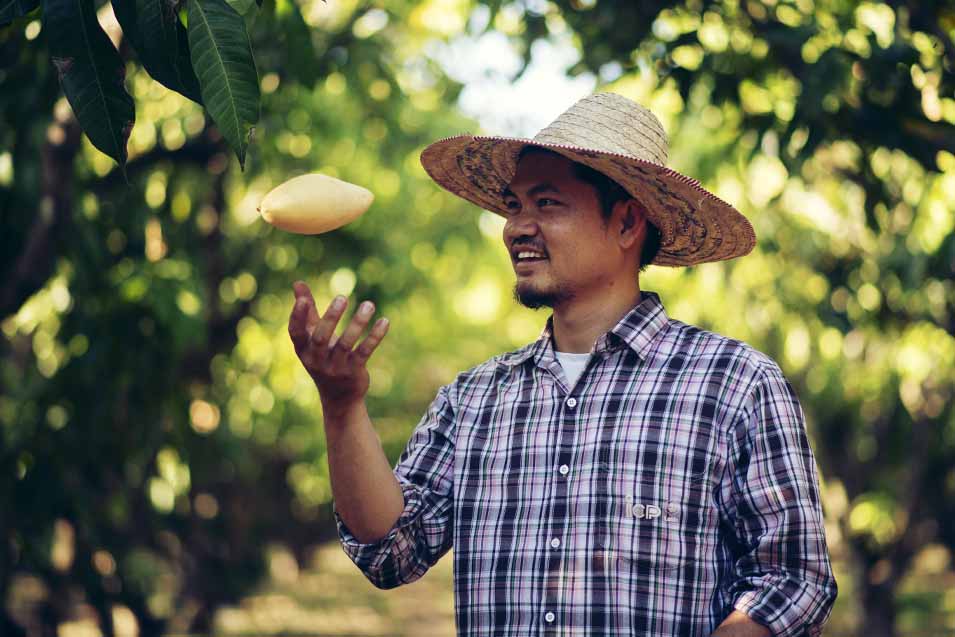
A newer type of wood is taking over the furniture scene, and it comes from one of the world’s most beloved exotic fruits: the mango. Mango wood is taken from mango trees. It is a member of the same family of plants as cashews and poison ivy. The tree itself remains green all year round and grows to heights of approximately 50 to 60 feet. It is classified as a hardwood, making it highly desirable for use in furniture making for its strength and durability. Mango wood is highly resistant to damage and maintains its finish for longer periods of time, allowing each piece of furniture to remain useful and attractive for many years. But best of all, mango wood is available at a far cheaper price point than other types of hardwood, and it is also sustainable, a big bonus in today’s market.
Where Does Mango Wood Come From?
Mango trees are indigenous to several different countries including India, Myanmar, and East Asia. Most often, the wood is prepared in India, but it is also becoming readily available in both Kenya and China.
Mango trees have a rapid growth trajectory, reaching full maturity in approximately 10-15 years. Once the tree is fully grown, it becomes less fruitful, making it the ideal time for it to be harvested for its wood. Because the mango tree is not desirable in its community when it no longer bears fruit, the tree would be cut down and replaced anyway, making using this tree for its wood an excellent means of recycling a resource. Using mango wood in this way helps protect other more endangered species of wood as well since it is cheaper and more readily available for use.
What is the Color of Mango Wood?
Mango wood in its natural state is golden in hue. However, some trees have wood that take on a yellow color or that are sprinkled with black or pink stripes throughout the surface. Mango wood can be discolored as a result of a condition known as “spalting.” Spalting occurs when the tree is affected by a fungus which imbues the wood’s finish with streaks ranging in color from light blonde to a rich ebony. This look is highly sought after by designers and is considered to be quite beautiful.
Typically, mango wood is not treated with a stain. Instead, it is coated with a clear wax. The end product is darker than oak and has a more noticeable grain.
Though many prefer mango wood’s natural hue, it does take stain very well and can easily be stained a variety of colors with deep brown being one its most attractive shades.
What is Mango Wood Used For?
Mango wood is a great choice for woodwork since it is exceptionally easy for craftsmen to work with. This attractive hardwood lends itself well to cutting and shaping. It is also soft enough that it can be carved to create unique designs in its surface.
Mango wood makes a great choice for outdoor furniture since it repels water and is unlikely to succumb to damage from moisture. But mango wood is not limited to use in furniture, it is also used to make such items as:
- Flooring
- Panelling
- Veneer
- Plywood
- Musical instruments
- Kitchen goods
- Turned objects
- Cutting boards
- Serving trays
But believe it or not, mango wood is not only useful in furniture or home décor items. Mango wood is also commonly utilized for pet products, including such popular items as dog dishes, cat trees, and even some chews, treats, and toys.
What are the Advantages of Using Mango Wood?
There are many advantages to be gained from the use of mango wood in furniture making and home décor items. These include:
Sustainable
Mango wood is a highly sustainable product because of its two-fold uses: first, as a fruit tree then as a type of wood once fully mature and no longer fruit-bearing. Compared to other hardwood trees, the mango tree grows at a rapid rate, reaching its full height and size at approximately 15 years. Once these trees no longer bear fruit, they are then cut down and new ones are planted. Utilizing these trees as a source of hardwood for a variety of different goods encourages an important cycle of sustainability, taking strain off other more endangered hardwood species and allowing farmers a continuous harvest of fruit for the consumer market.
Inexpensive
Because of the mango tree’s contribution to sustainability, it is a very inexpensive material to work with. Once the tree has been cut down, it is quite easy to process then to cut and shape for use in furniture or other wood items. Because the mango tree is inexpensive to process, cost savings are passed along to the consumer purchasing products crafted from it.
Durable
Mango wood can take a beating and still maintain its beautiful appearance. Because it is such a durable material, it is the ideal choice for furniture that would normally be created from the more traditional and more expensive ash or oak. This durability ensures that anything built from mango wood is sure to last.
Attractive
No one wants to purchase furniture simply because it has great longevity. Style is important too. Products made from mango wood are extremely attractive. Its unique wood grain is highly visually appealing.
What is the Best Way to Care for Mango Wood Products?
To keep mango wood products looking their very best, there are a few important steps homeowners should take. These include:
Wiping up spills
Though mango wood is water resistant, it can stain or remove the finish if liquid is allowed to remain on the surface for a prolonged period of time.
Make use of furniture polish
Furniture polish restores the natural oils in mango wood products. This type of cleaner will help to prevent cracking from occurring and will also enhance the natural wood grain.
Use non-abrasive cleaners
All furniture requires a good cleaning now and again. To keep mango wood from becoming damaged, it is a good idea to select a gentle cleaner that is free from heavy chemicals or rough cloths and cleaning tools.
Keep the furniture out of direct sunlight and heavy warmth
Both heat and excess light can cause fading of the wood. Position all mango wood furniture out of direct sunlight and heat for best results.
Thinking it’s time for a furniture upgrade? Why not consider something constructed from mango wood. It’s sustainable, durable, attractive, and affordable! What could be better?





